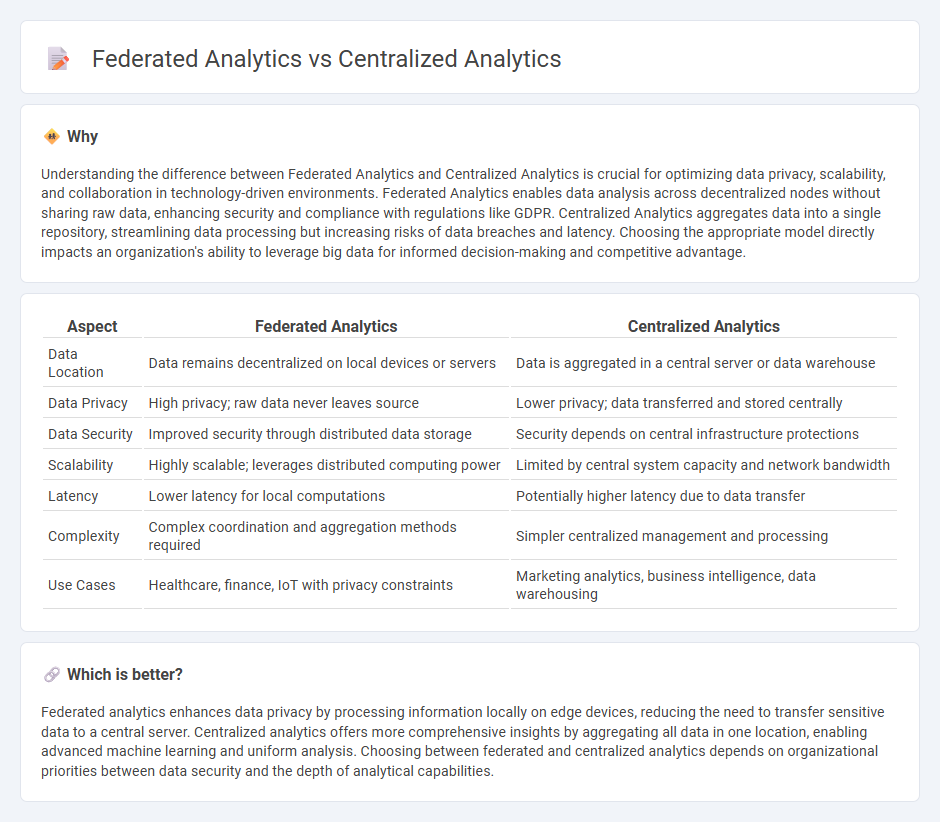
Federated analytics processes data locally on distributed devices, enhancing privacy and reducing data transfer costs, while centralized analytics consolidates data in a single location for comprehensive analysis and simpler infrastructure management. Federated approaches support compliance with data protection regulations like GDPR by minimizing sensitive data exposure. Explore the differences and applications of federated versus centralized analytics to optimize your data strategy.
Why it is important
Understanding the difference between Federated Analytics and Centralized Analytics is crucial for optimizing data privacy, scalability, and collaboration in technology-driven environments. Federated Analytics enables data analysis across decentralized nodes without sharing raw data, enhancing security and compliance with regulations like GDPR. Centralized Analytics aggregates data into a single repository, streamlining data processing but increasing risks of data breaches and latency. Choosing the appropriate model directly impacts an organization's ability to leverage big data for informed decision-making and competitive advantage.
Comparison Table
| Aspect | Federated Analytics | Centralized Analytics |
|---|---|---|
| Data Location | Data remains decentralized on local devices or servers | Data is aggregated in a central server or data warehouse |
| Data Privacy | High privacy; raw data never leaves source | Lower privacy; data transferred and stored centrally |
| Data Security | Improved security through distributed data storage | Security depends on central infrastructure protections |
| Scalability | Highly scalable; leverages distributed computing power | Limited by central system capacity and network bandwidth |
| Latency | Lower latency for local computations | Potentially higher latency due to data transfer |
| Complexity | Complex coordination and aggregation methods required | Simpler centralized management and processing |
| Use Cases | Healthcare, finance, IoT with privacy constraints | Marketing analytics, business intelligence, data warehousing |
Which is better?
Federated analytics enhances data privacy by processing information locally on edge devices, reducing the need to transfer sensitive data to a central server. Centralized analytics offers more comprehensive insights by aggregating all data in one location, enabling advanced machine learning and uniform analysis. Choosing between federated and centralized analytics depends on organizational priorities between data security and the depth of analytical capabilities.
Connection
Federated analytics and centralized analytics are connected through their shared goal of analyzing distributed data while balancing privacy and efficiency. Federated analytics enables data processing locally on devices or nodes, sending aggregated insights to a central system, which aligns with centralized analytics' need for consolidated data analysis. This connection allows organizations to harness distributed data sources without compromising security or control inherent in centralized analytics models.
Key Terms
Data Centralization
Centralized analytics consolidates data into a single repository, enabling comprehensive analysis and streamlined reporting while ensuring data consistency and governance. Federated analytics processes data locally across multiple sources, preserving data privacy and enabling real-time insights without data movement. Discover how these approaches impact data centralization strategies and analytics effectiveness in your organization.
Data Privacy
Centralized analytics stores sensitive data in a single repository, increasing the risk of data breaches and privacy violations due to consolidated access points. Federated analytics processes data locally across distributed nodes, enhancing data privacy by keeping raw data within its origin and only sharing aggregated insights. Explore how federated analytics can safeguard your data privacy while enabling robust business intelligence.
Model Aggregation
Centralized analytics collects all data into a single repository for model training, enabling comprehensive data analysis but raising privacy and security concerns. Federated analytics processes data locally across multiple devices or nodes, aggregating model updates rather than raw data to preserve confidentiality and reduce data transfer overhead. Explore the nuances of model aggregation techniques to understand their impact on performance and data privacy.
Source and External Links
Centralized vs. Decentralized Analytics - iDashboards - Centralized analytics enables oversight and coordination by a core data team, promoting best practices and consistent metrics across departments, though it may not always address unique departmental needs.
Organizing Analytics from the inside out - Deloitte - A centralized analytics organization facilitates cross-functional projects and resource sharing, but can become unresponsive to specific business needs without effective operational mechanisms.
Best practice 12.2 - Build local or build centralized data analytics platforms - Centralized analytics platforms improve resource utilization, compliance, and governance, while local resources offer more agility and customization for individual teams.
 dowidth.com
dowidth.com